What is Your Diagnosis of this Fetus?
This is the case of a routine ultrasound examination at 31 weeks gestation.
This is the case of a 31-week-old gestation in for a routine ultrasound examination.
History and Symptoms: This young woman came to our clinic for routine ultrasound examination at 31 weeks. She had normal menstrual cycles before the pregnancy and did not have any history of major illness. She had a mild fever 2 days before her sonographic examination. She had no previous history of abdominal surgery.
Family History: She has 1 healthy child, who was delivered at full term by LSCS. This mother (the patient) is one of 2 children.
Present Pregnancy: The pregnancy has progressed normally, and the patient has undergone routine sonography to rule out fetal anomalies or any other pathology, and to evaluate the biophysical profile of the fetus.
Clinical Examination: Mildly elevated blood pressure (BP: 146/ 90 mm. of Hg). On abdominal examination, the fundal height was less than normal for the gestational age.
Imaging Studies: This patient underwent routine obstetric ultrasound to rule out any fetal pathology. Color Doppler ultrasound imaging was also essential in this patient.
Spectral Doppler waveform and ultrasound images of the umbilical artery showed, (see images below and click to enlarge).
Image-01: Umbilical artery waveform:
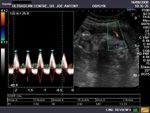
Image-2: Umbilical artery

What are your findings?
In the B-mode ultrasound images, the amniotic fluid is normal in amount with a reasonably large pocket of fluid in the fundus. The placenta is fundic-anterior, but the umbilical artery spectral Doppler tracing is not normal. Can you spot the abnormalities?
The normal umbilical artery waveform should show a high diastolic flow. Is that the case here? The systolic flow shows normal peaking; but the diastolic flow is markedly low and in fact is reversed! This reversed diastolic flow is an ominous indicator and signifies markedly increased resistance in the umbilical artery. The resistance index (RI) is 0.92- clearly raised. This finding calls for more detailed examination of the other fetal vascular parameters- the cerebral artery and the ductus venosus.
The cerebral artery and the ductus venosus imaging
Image-03: Middle cerebral artery
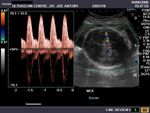
Image-04: Middle cerebral artery
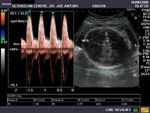
The spectral waveform of the MCA also shows some definite pathological changes. Can you spot them?
MCA Doppler Findings
The most striking finding on the MCA waveform is the markedly increased diastolic flow. This is not normal. A normal MCA should show low diastolic high resistance flow. Vasodilation of the MCA with high diastolic MCA flow signifies a major pathology in the fetal circulation. The MCA shows an RI value of 0.75, which is lower than the RI of the umbilical artery. What is the meaning of the umbilical artery and MCA tracing findings? Shall we also see the ductus venosus tracing?
Image-05: Ductus vensus
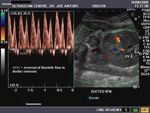
Image-06: Ductus venosus
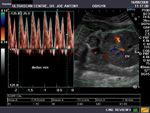
The ductus venosus also shows marked increase in resistance in this vessel with low and/ or as in this case- reversed flow during diastole. The RI values of the ductus = 0.99 (definitely abnormal). What is the implication of these Doppler ultrasound findings?
What is your diagnosis? Add your comments below then read the discussion.
Discussion
This fetus also showed low estimated fetal weight in addition to the Doppler findings. The abdominal circumference was about 28 weeks compared to the HC of 31 weeks. Clearly this is a severely growth retarded fetus. The diagnosis here is fetal IUGR (intrauterine growth retardation). The Doppler findings suggest presence of significant placental insufficiency with associated maternal hypertension. In this fetus the fetal circulation is being diverted to the brain (the brain sparing effect) due to fetal hypoxia resulting from poor flow (high resistance) in the umbilical arteries. This brain sparing effect is seen as the increased diastolic flow in the fetal MCA. The increased resistance in the ductus venosus and the umbilical arteries is reflected in the diastolic flow reversal seen in these two vessels. In addition, the altered cerebro-placental ratio (or CPR which is less than 1 in this fetus) shows the degree of fetal hypoxia. The CPR= RI OF MCA/ RI OF UMBILICAL ARTERY= 0.75/0.92 = 0.81 (definitely altered).
Final Diagnosis
Severe fetal IUGR with fetal hypoxia.
Prognosis
This fetus needs regular follow-up Doppler ultrasound evaluation and vigorous management to stave off possible fetal demise or neonatal complications such as intracranial hemorrhage and prolonged neonatal care. The chances of preterm delivery are also very high in such pregnancies with all its attendant complications.
Related Content
The DailyDxUltrasound Case Studies
What are your thoughts? Add your comments below.
We challenge you to stump your colleagues!Send us your images or case study.
References:
References
1)Â Article on fetal IUGR- courtesywww.ultrasound-images.com
2)Â Manual of color Doppler sonography- Matthais Hofer
3) Doppler Ultrasound in Obstetrics and Gynecology - Dev Maulik
4) Imaging in IUGR- Medscape
S1E4: Dr. Kristina Adams-Waldorf: Pandemics, pathogens and perseverance
July 16th 2020This episode of Pap Talk by Contemporary OB/GYN features an interview with Dr. Kristina Adams-Waldorf, Professor in the Department of Obstetrics and Gynecology and Adjunct Professor in Global Health at the University of Washington (UW) School of Medicine in Seattle.
Listen
Study shows a healthy prenatal diet could be upstream obesity prevention strategy
December 26th 2024"Our findings support the recommendation of a healthy diet based on the current guidelines (as measured by the HEI) during pregnancy, since it may reduce patterns of infant growth outside reference ranges."
Read More
Early pregnancy cannabis use high in states with recreational legalization
November 11th 2024A population-based time-series analysis California before, during and after legalization show a rising trend in women using cannabis while pregnancy especially when the state has legalized the drug.
Read More
